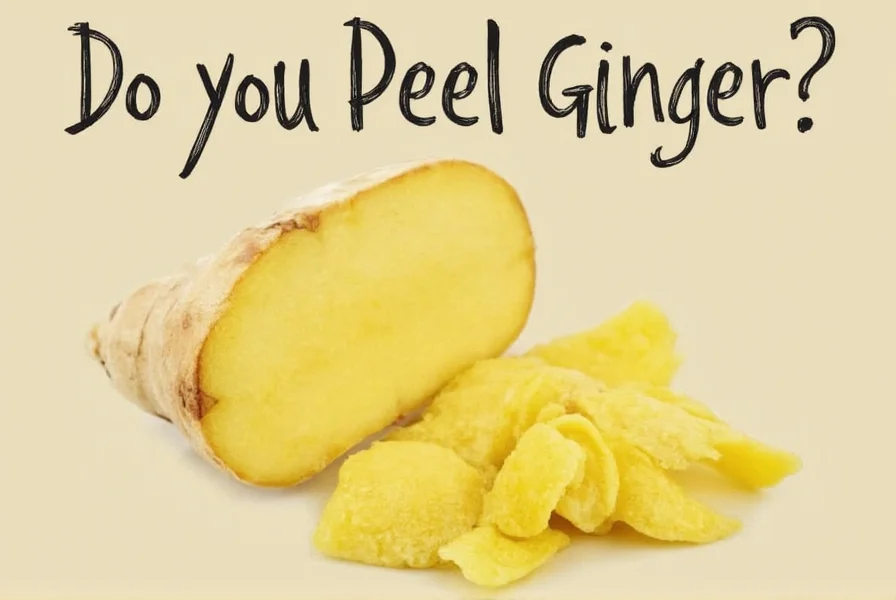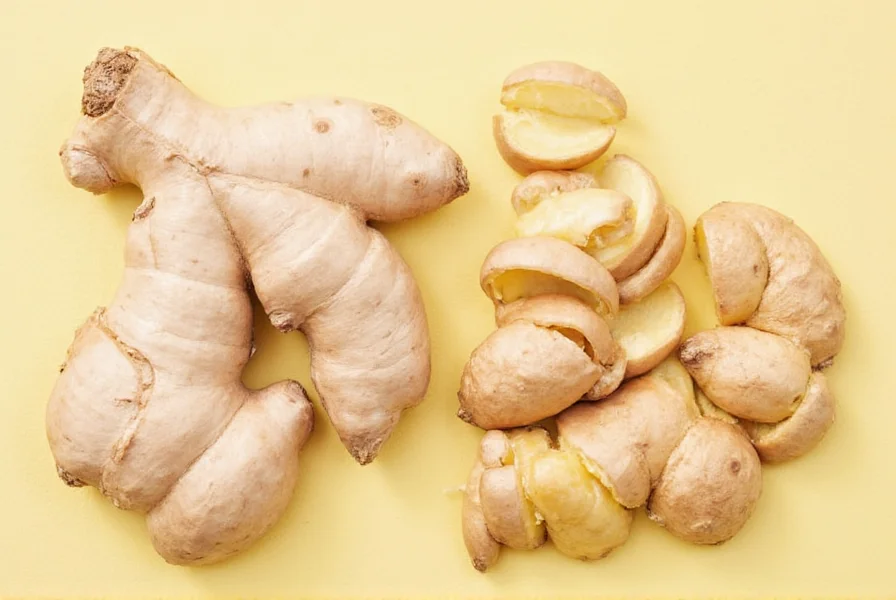When preparing ginger for cooking, many home chefs wonder whether peeling is necessary. This common kitchen question affects both flavor preservation and food waste reduction. Understanding when to peel ginger versus when you can skip this step makes your cooking process more efficient while maximizing the root's nutritional benefits.
Understanding Ginger Varieties and Their Skins
Ginger comes in different varieties, primarily categorized by age. Young ginger (often called spring ginger) has a thin, tender skin that's barely visible. This variety typically appears in early spring and has a higher moisture content with a milder flavor. Mature ginger, available year-round but especially in fall and winter, develops thicker, tougher skin with more pronounced wrinkles as it ages.
| Ginger Type | Skin Characteristics | Peeling Recommendation |
|---|---|---|
| Young Ginger | Thin, smooth, pale yellow | Not necessary |
| Mature Ginger | Thick, tough, deeply wrinkled | Recommended |
| Preserved Ginger | Varies by preservation method | Depends on recipe |
When Peeling Ginger Is Recommended
Certain cooking scenarios make peeling ginger advisable. For recipes requiring smooth textures like sauces, soups, or baked goods, removing the skin prevents fibrous bits from affecting the final product's consistency. Older ginger with particularly tough skin often contains bitter compounds concentrated in the outer layer, which peeling eliminates.
Professional chefs preparing dishes where visual presentation matters frequently peel ginger to achieve uniform color and texture. This practice proves especially important in fine dining applications or when creating clear broths and consommés where any fiber would be noticeable.
When You Can Skip Peeling Ginger
For many everyday cooking applications, peeling ginger proves unnecessary. The skin contains valuable nutrients and fiber, so leaving it on maximizes nutritional benefits. When making stir-fries, curries, or other dishes where texture matters less, simply scrubbing the ginger clean works perfectly.
Many traditional Asian recipes specifically call for unpeeled ginger, recognizing that the skin contributes to both flavor complexity and nutritional value. When using young ginger with its paper-thin skin, peeling becomes virtually pointless as the skin blends seamlessly into preparations.
Effective Methods for Cleaning Ginger Without Peeling
If you decide against peeling, proper cleaning ensures your ginger remains free of dirt and contaminants. The most effective technique involves using a spoon to scrape away surface dirt. The curved edge of a teaspoon works perfectly against ginger's irregular shape, removing debris without wasting edible material.
Alternatively, a soft vegetable brush under running water effectively cleans ginger's surface. For recipes requiring grated ginger, many chefs find that grating directly through the skin produces excellent results, with the skin incorporating seamlessly into the final dish. This method works particularly well with younger ginger varieties.

Nutritional Considerations: Skin vs. No Skin
The skin of ginger contains concentrated antioxidants and fiber that contribute to its health benefits. Research indicates that leaving the skin on preserves up to 20% more of ginger's beneficial compounds compared to peeled ginger. The outer layer contains higher concentrations of gingerols, the active compounds responsible for many of ginger's medicinal properties.
When preparing ginger for medicinal uses like teas or tinctures, keeping the skin intact maximizes potency. However, for culinary applications where texture matters more than maximum nutrient retention, peeling might still be preferable depending on the specific recipe requirements.
Practical Tips for Ginger Preparation
For those wondering how to prepare ginger without peeling, consider these professional kitchen techniques. When making ginger tea, simply slice unpeeled ginger thinly for maximum flavor extraction. For stir-fries, julienne unpeeled ginger into fine matchsticks that will cook down completely during the high-heat process.
If you're concerned about pesticide residues on conventionally grown ginger, soaking in a vinegar-water solution (1 part vinegar to 3 parts water) for 10-15 minutes effectively removes surface contaminants without requiring peeling. Organic ginger typically requires only a thorough rinse under running water.

Conclusion: Making the Right Choice for Your Recipe
Whether to peel ginger ultimately depends on your specific cooking application, the ginger's age, and personal preference. Understanding these factors helps you make informed decisions that balance flavor, texture, nutrition, and efficiency in your kitchen. By recognizing when peeling adds value versus when it creates unnecessary work and waste, you'll become a more thoughtful and efficient cook.
Frequently Asked Questions
Can you eat ginger skin?
Yes, ginger skin is completely edible and contains valuable nutrients. The skin becomes more fibrous in older ginger, which might affect texture in certain dishes, but it's safe to consume and adds nutritional benefits.
What's the best tool for peeling ginger?
A spoon works better than a traditional peeler for ginger. The edge of a teaspoon can easily follow ginger's irregular shape, removing minimal flesh while effectively eliminating the skin. This method reduces waste compared to using a vegetable peeler.
Does unpeeled ginger taste different?
Unpeeled ginger has a slightly more complex flavor profile as the skin contains concentrated compounds. In most recipes, the difference is subtle, but in delicate preparations, peeled ginger might provide a cleaner, more uniform flavor.
How do you store unpeeled ginger?
Store unpeeled ginger in the refrigerator's crisper drawer in a paper bag or wrapped in a paper towel inside a plastic bag. This method keeps ginger fresh for 2-3 weeks. For longer storage, freeze whole unpeeled ginger and grate it frozen as needed.
Is it necessary to peel ginger for tea?
No, peeling ginger for tea is unnecessary and potentially counterproductive. The skin contains beneficial compounds, and slicing or crushing unpeeled ginger actually releases more flavor and nutrients into your tea.










 浙公网安备
33010002000092号
浙公网安备
33010002000092号 浙B2-20120091-4
浙B2-20120091-4